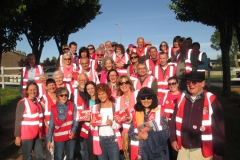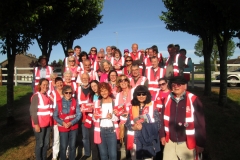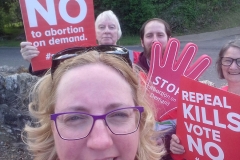Are women’s lives protected without abortion?
answer
YES!
Abortion is not necessary to save a woman’s life. Women will always be treated if life-threatening condition arises in pregnancy, even if that means the life of the baby is lost. Treatment for conditions arising in pregnancy, such as pre-eclampsia or sepsis, are NOT abortions, even if the life of the baby is lost, as the intention is not to harm the baby.
Doctors say that the 8th amendment has NEVER caused Irish women to be denied life-saving medical treatments for any condition that might arise in pregnancy. Abortion is not healthcare. Good healthcare saves lives – the purpose of abortion is to end a life.
More than 1000 doctors have now signed the Dublin Declaration which states that abortion is not needed to save the life of a woman.
REAL LIFE
Pregnant with cancer
Audrey McElligott from Dundalk was diagnosed with cancer in 2012, when she was three months pregnant. She underwent surgery at six months pregnant, and was diagnosed with Hodgkins Lymphoma Stage Four. Having undergone three stages of chemotherapy, she gave birth to a healthy baby boy in 2013. Ireland’s ban on abortion did not prevent her doctors from fully treating Audrey’s cancer. Abortion is not needed to treat cancer or another condition arising in pregnancy.
What do Doctors say?
Obstetricians and gynecologists (the doctors who care for women in pregnancy) have repeatedly gone on the record to say that abortion is not needed to save women’s lives, and that there is an important difference between an intervention to save a woman’s life where the baby might be lost, and an abortion, where the sole purpose is to kill the baby.
In 2013 a major Dáil inquiry heard from leading medical experts on abortion.
Senator Dr John Crown asked the doctors if they were aware of instances where there had been “needless maternal deaths” because of the ban on abortion.
The Obstetricians confirmed that they did not know of ANY situation where a woman had lost her life in Ireland because she was denied treatment because of our abortion ban.
They also said they were not aware of ANY situation where they or other doctors had been prevented from providing life-saving medical treatment by Ireland’s laws on abortion.
They also confirmed that not one woman had committed suicide in their hospitals because she could not obtain an abortion.
It was also clarified that all life-saving treatments were always provided to women with cancer arising in pregnancy
The difference between a life-saving intervention and abortion
The difference between abortion and life-saving interventions was also explained. Doctors were asked about the difference between terminating a pregnancy and terminating the life of an unborn child.
Dr Sam Coulter Smith said that in most situations it was possible to “deliver the foetus rather than kill the unborn” while Dr Rhona Mahony said that while delivery before viability might be required there was “no intention to kill the foetus”.
Doctors have been saying this consistently
In 2000, an Oireachtas Committee also looked at this issue.
Professor John Bonnar, the then Chairman of the Institute of Obstetricians and Gynaecologists, testified that:
“95% of members of the Institute of Obstetricians and Gynaecologists surveyed said that they could preserve mother’s lives and health without abortion.”
The Institute of Obstetricians and Gynaecologists submitted that:
“We consider that there is a fundamental difference between abortion carried out with the intention of taking the life of the baby, for example for social reasons, and the unavoidable death of the baby resulting from essential treatment to protect the life of the mother.”
In addition, Dr Frédéric Amant, a world-renowned cancer specialist, has recently stated that:
“In the case of cancer complicating pregnancy, termination of pregnancy does not improve maternal prognosis”.
The International Symposium on Maternal Health released a statement (now signed by 1000+ medical experts) stating:
“We confirm that the prohibition of abortion does not affect, in any way, the availability of optimal care to a pregnant woman.”
Currently in Ireland, where women have the protection of the 8th amendment, pregnant mothers are given all the medical treatment necessary to save their lives in life threatening situations, including occasionally delivering their babies prematurely if required. Even though there is a chance the baby may not survive, doctors would make every attempt to save both the mother and the child in these circumstances.
Ireland is one of the Safest places to be pregnant
The guidelines of the Irish Medical Council stated that doctors must give all necessary medical treatment to pregnant women, even if it results in the unintentional death of the baby. This is not an abortion.
Abortion activists says that the 8th amendment puts women’s lives in danger. This is both misinformation as well as dangerous propaganda. The 8th amendment means that Irish doctors must protect both mother and baby and this law had made Ireland one of the safest places in the world for a woman to have a baby.
According to a 2007 report on Maternal mortality by the World Health Organization, Unicef, UNFPA, and the World Bank, Ireland has one of the lowest instances of maternal mortality (maternal death) in the entire world.
The record shows that our laws have saved the lives of unborn babies and also kept women safe.
The best way to protect the lives and interests of women is not to legalise abortion but to continue to work to provide to best health care and support to women facing challenging pregnancies.
What about Savita Halappanavar?
Savita Halappanavar died tragically in a Galway hospital in 2012, from an infection in the blood (sepsis) arising from E-Coli ESBL, a dangerous strain of bacteria resistant to most antibiotics.
Official inquiries into her death found that the real issue was the management of sepsis, not abortion. The Health Information and Quality Authority (HIQA) Inquiry in October 2013 found that her medical team missed 13 opportunities to intervene and save her life. Staff failed to diagnose the ESBL infection which led to her death, and did not understand that her life was in danger. It is normal in cases of miscarriage to take a wait and see approach, as unnecessary intervention can be harmful. If, however, the doctors in Savita’s case had realised in time that her life was in danger, they were free under Irish law to intervene and give her all necessary medical treatment, even if that treatment resulted in the early demise of her baby.
In fact, Dr Sam Coulter Smith, Master of the Rotunda Hospital, told an Irish Medical Organisation conference in April 2013 that he had acted to save the mother’s life when severe sepsis arose four times in the previous year, and that, while the interventions led to the loss of the baby’s life, these were not abortions but interventions to save the life of the mother.
The perception that Savita’s death was as a result of Ireland’s ban on abortion was created by the pro-abortion lobby who wanted to use her case in order to legalise abortion, and conveniently ignored all the medical evidence in the case.
Would an abortion have saved Savita’s life?
This claim was made by Dr Peter Boylan – but he was brought to task by 11 senior Obstetricians for making that claim who wrote an open letter printed in the Irish Times pointing out that no doctor can predict a clinical outcome with certainty, and that E.coli ESBL is a particularly difficult bacteria to treat.
The question which should be asked is this: did the 8th amendment prevent the doctors from acting to save her life and the answer is clearly no, it did not and we have evidence to support that. Not only do we have three independent enquiries finding that the mismanagement of a septic miscarriage is what lead to Savita’s death we also know that the 8th Amendment did not stop Dr Sam Coulter Smith terminating 4 pregnancies at the Rotunda Hospital due to sepsis in the preceding year (see above).
The Irish Times and the abortion that wasn’t
Furthermore, in a rush to glorify the abortion legislation, the Irish Times ran a piece in August 2013 claiming that the first abortion had been carried out at the National Maternity Hospital on a woman who was pregnant with twins and was developing signs of sepsis and drew a parallel to Savita’s case even going as far as suggesting that had the legislation been enacted sooner than perhaps Savita too would be alive. But in an embarrassing turn of events for the newspaper it emerged that the legislation had not yet been enacted and the doctors were operating under the same law and guidelines as those caring for Savita.
Was the woman arrested and sentenced to 14 years in prison? No. Were the doctors arrested and stripped of their license to practice? No, because as Barrister at Law Simon Mills pointed out, the procedure was perfectly legal irrespective of the law on abortion. So it is clear that it was not the 8th Amendment that cost Savita her life, the law clearly allows for such intervention where there is sepsis in pregnancy, it was a missed diagnosis, and a delay in treatment that contributed to Savita’s death.
What about other countries?
Abortion is widely available in Britain and in the US – both countries have higher rates of maternal death than Ireland according to the World Health Organisation. http://www.who.int/reproductiv...
In Chile, the abortion law was overturned in 1989, and a ban on abortion was put in place. Since that time maternal mortality figures have decreased by almost 70%, thereby giving lie to the argument that a lack of legal abortion places women’s lives at risk. Deaths from illegal abortions also decreased by an enormous 99% in that period.
The researchers found that increasing education levels, access and utilization of maternal health facilities, and improvements of the sanitary system were amongst the factors that made women safer in pregnancy. Abortion was not.
Koch et al: Women’s Education Level, Maternal Health Facilities, Abortion Legislation and Maternal Deaths: A Natural Experiment in Chile from 1957 to 2007. PLoS One
CONTACT US
LIFECANVASS6 Gardiner PlaceDublin 1
info@yestolifeireland.org
SIGN UP NOW!
Let us know if you are interested in joining up with a LIFECANVASS team in our area.
SIGN UP NOW!FOLLOW US






SUBSCRIBE FOR UPDATES
Get News and Info!
Email Address *
First Name
Last Name
GALLERY
Not the answer you're looking for?
ask a question
Looking for help?
contact us






